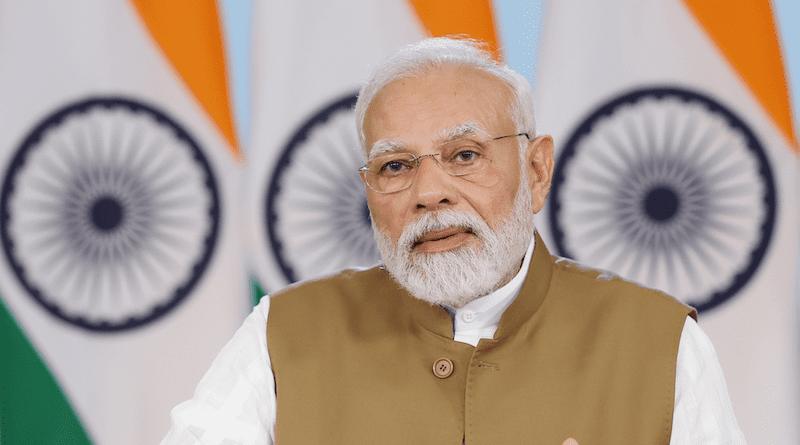Modi’s Election Target: Can The BJP Achieve It? – Analysis
By Institute of South Asian Studies
By Ronojoy Sen
India’s general election, the world’s largest electoral exercise, will be held from 19 April to 1 June 2024. Prime Minister Narendra Modi and the Bharatiya Janata Party have been successfully pushing the narrative that the election results are a foregone conclusion and it is only a matter of their party increasing its numbers. Earlier this year, Modi unusually made a prediction about the poll results in parliament, announcing that the BJP will win at least 370 of the 543 Lok Sabha (Lower House) seats and the BJP-led National Democratic Alliance (NDA) will cross 400 seats.
Since then, this narrative has been bolstered by Modi and other senior BJP leaders who have repeatedly emphasised their intended target. Indeed, the BJP’s slogan for the coming election is “Abki baar, 400 paar” (This time, above 400). The BJP, on its own, has 303 seats in the outgoing Lok Sabha. A significant increase in the party’s seat share would be required to reach the intended target. Does the BJP’s target make sense and, if so, where will it win the additional seats?
There is not much scope for improvement for the BJP in the Hindi belt – north and central India – as well as in western India where it had an exceptional strike rate in the 2019 general election. In some states in this large region – Gujarat, Bihar, Madhya Pradesh, Haryana, Rajasthan, Chhattisgarh, Jharkhand, Delhi, Himachal Pradesh, Uttarakhand and Goa – the BJP, either on its own or with allies, had a strike rate of over 90 per cent in 2019. These are also states, with the exception of Bihar, Jharkhand, Delhi and now Haryana (with the split of the BJP with its ally, the Jannayak Janta Party), where the BJP’s primary opponent is the Congress against whom it has an exceptionally high success rate.
In some states, where the BJP has a lower strike rate, it has room to increase its footprint. Of these, the BJP, along with its allies, already has an 80 per cent strike rate in Uttar Pradesh (UP) and 85 per cent in Maharashtra which collectively have 128 seats. In UP, the BJP could add to its tally of 62 seats won in 2019, given the diminished state of the opposition Bahujan Samaj Party, which won 10 seats in 2019. However, in Maharashtra, where the BJP and the undivided Shiv Sena won 41 of 48 seats, the situation is more complex. The Sena has split with one faction, led by Chief Minister Eknath Shinde, allied with the BJP, and the other, led by Uddhav Thackeray, with the opposition, comprising the Congress and the Sharad Pawar faction of the Nationalist Congress Party. The changed ground reality could pose challenges to the BJP. In the northern state of Punjab and the Union Territory of Jammu and Kashmir, the BJP also has had a poor strike rate and the chances of improvement are slim.
In eastern India, primarily West Bengal and Odisha, which have a combined 63 seats, the BJP has made inroads and sees scope for expansion. In 2019, the BJP won 18 of 42 seats in West Bengal and eight of 21 seats in Odisha. It is looking to make gains in these two states, particularly in West Bengal, where Modi has made several trips in the recent past, though it faces a strong regional party in Trinamool Congress. The situation is somewhat different in Odisha with the BJP and the Biju Janata Dal (BJD) cooperating in parliament, but efforts at an alliance falling through. The BJD has also been hit by internal discontent, which could work to the BJP’s advantage. In Assam, which has 14 seats, the BJP had a strike rate of 64 per cent in 2019 and could eke out a few more seats.
Apart from Karnataka, southern India has been most resistant to the BJP and Modi. The southern states send 130 MPs to the Lower House. In 2019, the BJP won 29 seats with 25 coming from Karnataka alone. The BJP is making a concerted southern push with Modi having already visited Tamil Nadu six times in 2024. The south, along with the east, will be crucial to the BJP’s goal of increasing its tally. In Karnataka, which sends 28 MPs, there is hardly any scope for improvement. Indeed, the BJP, which has tied up with Janata Dal (Secular), faces a rejuvenated Congress which is now in power in Karnataka as well as internal dissent. The BJP’s best prospects are in Telangana where it won four seats in 2019. However, there too, the BJP faces a reinvigorated Congress which came to power in 2023. In Andhra Pradesh, Tamil Nadu and Kerala, the BJP drew a blank in 2019. It could open its account in these states, especially in Andhra Pradesh, where it has a tie-up with the Telugu Desam Party but might find it difficult to do more.
The BJP’s efforts to surpass its 2019 performance will depend on Modi’s popularity, particularly in areas where the party is weak. It will also be helped by its formidable electoral organisation funded by a huge war chest, filled largely by the electoral bonds scheme, which has recently been declared unconstitutional. In contrast, the opposition is fragmented, harried by central investigating agencies and seems unable to stitch a coherent narrative on issues like unemployment, electoral bonds and farmers’ discontent. However, despite the tailwind, the BJP could struggle to reach the target set by Modi.
- About the author: Dr Ronojoy Sen is Senior Research Fellow and Research Lead (Politics, Society and Governance) at the Institute of South Asian Studies (ISAS), an autonomous research institute at the National University of Singapore (NUS). He can be contacted at [email protected]. The author bears full responsibility for the facts cited and opinions expressed in this paper.
- Source: This article was published by Institute of South Asian Studies (ISAS)

